Detailed Nursing Report: Fran D'Santis Case Study and Treatment Plan
VerifiedAdded on 2020/10/22
|6
|1076
|386
Report
AI Summary
This nursing report presents a case study of Fran D'Santis, a 21-year-old patient experiencing recurrent seizures. The report delves into drug knowledge, detailing the use of phenytoin, lamotrigine, and sodium valproate, along with their mechanisms and indications. It outlines the clinical reasoning cycle applied to Fran's case, including data collection, problem identification, goal setting, action implementation, evaluation, and reflection. Furthermore, the report emphasizes patient awareness, highlighting the importance of educating Fran and her family about seizure management and the risks associated with alcohol and drug abuse. Finally, it discusses appropriate education strategies for health promotion, emphasizing seminars, webinars, and promotional campaigns to encourage healthy habits and prevent severe health problems. The report references several relevant sources, including books and journal articles, to support the information presented.
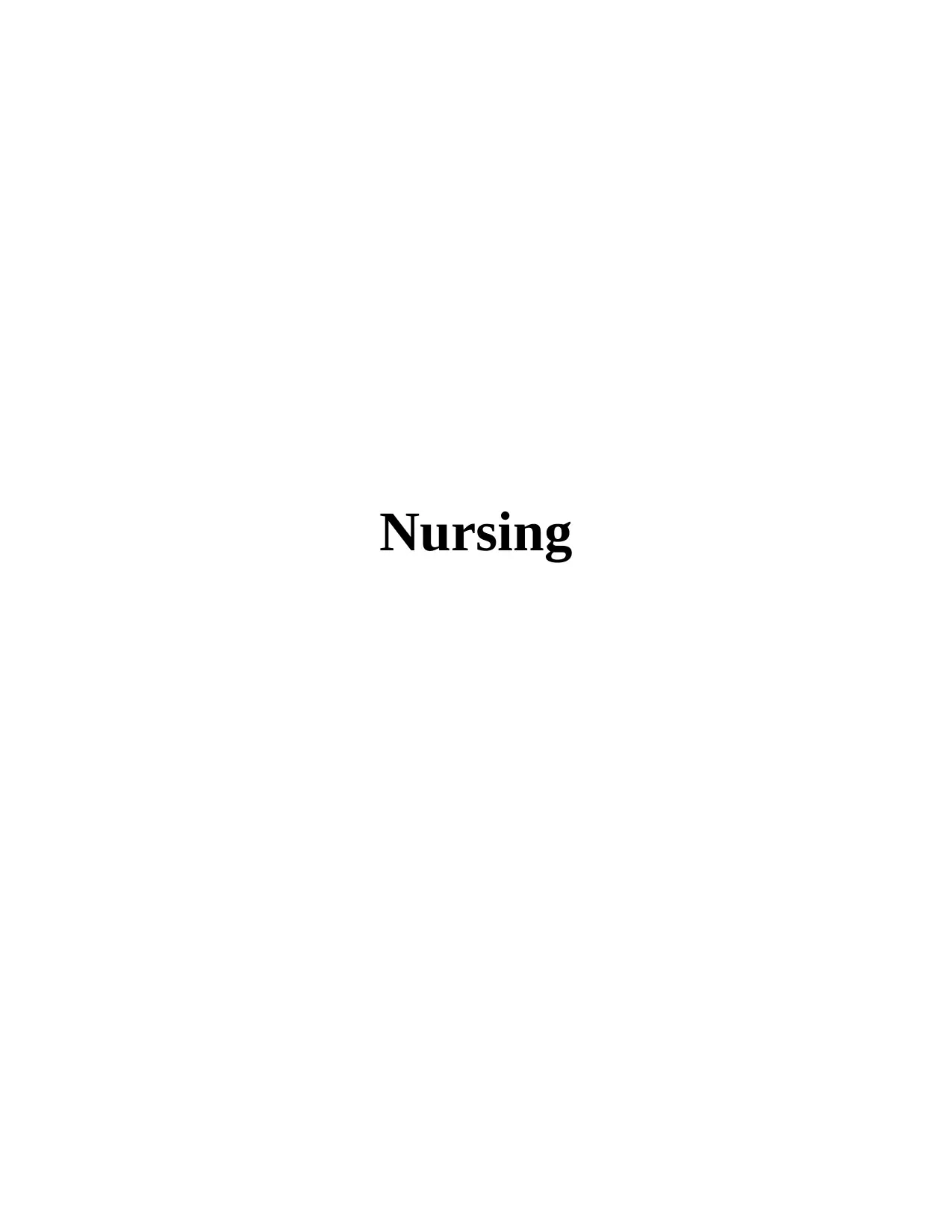
Nursing
Paraphrase This Document
Need a fresh take? Get an instant paraphrase of this document with our AI Paraphraser
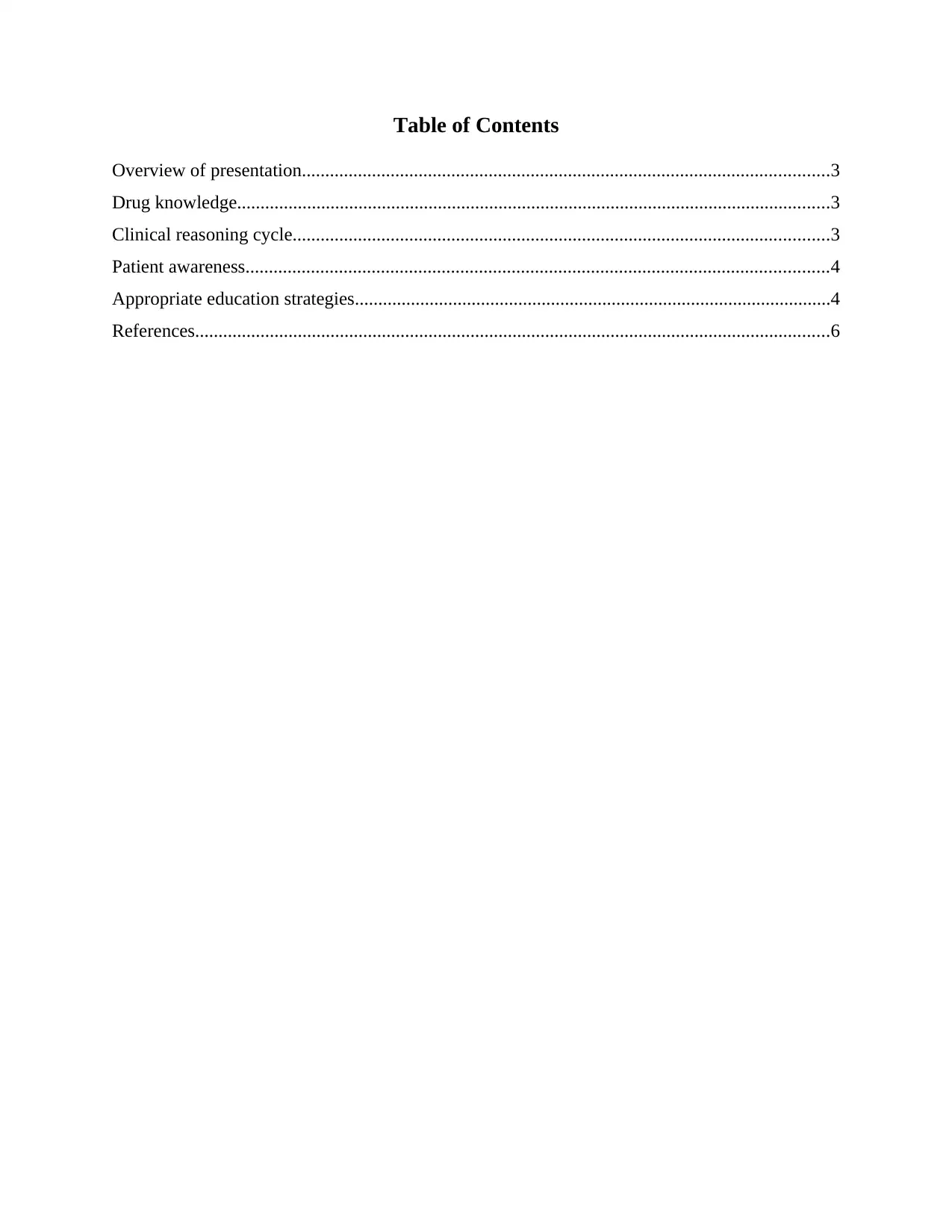
Table of Contents
Overview of presentation.................................................................................................................3
Drug knowledge...............................................................................................................................3
Clinical reasoning cycle...................................................................................................................3
Patient awareness.............................................................................................................................4
Appropriate education strategies......................................................................................................4
References........................................................................................................................................6
Overview of presentation.................................................................................................................3
Drug knowledge...............................................................................................................................3
Clinical reasoning cycle...................................................................................................................3
Patient awareness.............................................................................................................................4
Appropriate education strategies......................................................................................................4
References........................................................................................................................................6
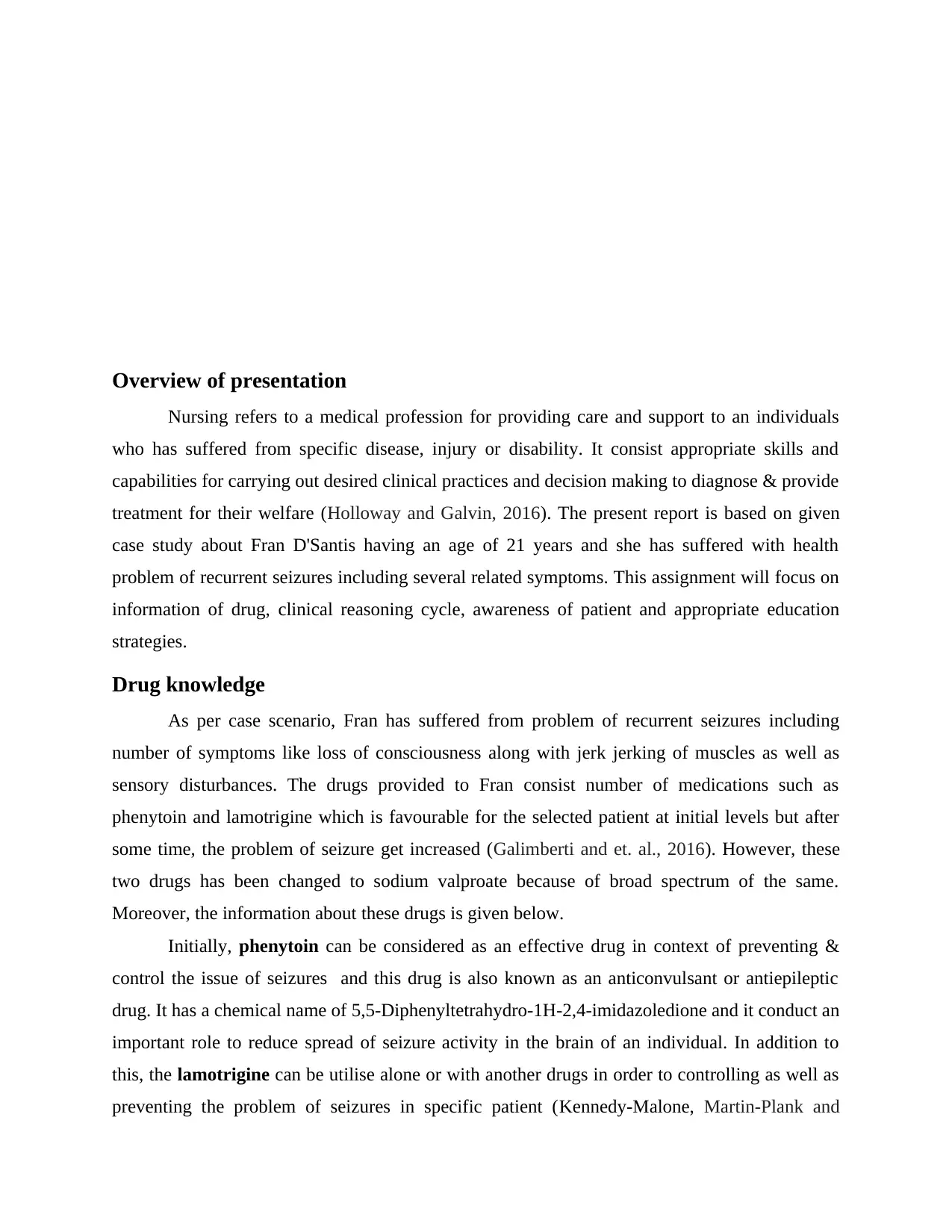
Overview of presentation
Nursing refers to a medical profession for providing care and support to an individuals
who has suffered from specific disease, injury or disability. It consist appropriate skills and
capabilities for carrying out desired clinical practices and decision making to diagnose & provide
treatment for their welfare (Holloway and Galvin, 2016). The present report is based on given
case study about Fran D'Santis having an age of 21 years and she has suffered with health
problem of recurrent seizures including several related symptoms. This assignment will focus on
information of drug, clinical reasoning cycle, awareness of patient and appropriate education
strategies.
Drug knowledge
As per case scenario, Fran has suffered from problem of recurrent seizures including
number of symptoms like loss of consciousness along with jerk jerking of muscles as well as
sensory disturbances. The drugs provided to Fran consist number of medications such as
phenytoin and lamotrigine which is favourable for the selected patient at initial levels but after
some time, the problem of seizure get increased (Galimberti and et. al., 2016). However, these
two drugs has been changed to sodium valproate because of broad spectrum of the same.
Moreover, the information about these drugs is given below.
Initially, phenytoin can be considered as an effective drug in context of preventing &
control the issue of seizures and this drug is also known as an anticonvulsant or antiepileptic
drug. It has a chemical name of 5,5-Diphenyltetrahydro-1H-2,4-imidazoledione and it conduct an
important role to reduce spread of seizure activity in the brain of an individual. In addition to
this, the lamotrigine can be utilise alone or with another drugs in order to controlling as well as
preventing the problem of seizures in specific patient (Kennedy-Malone, Martin-Plank and
Nursing refers to a medical profession for providing care and support to an individuals
who has suffered from specific disease, injury or disability. It consist appropriate skills and
capabilities for carrying out desired clinical practices and decision making to diagnose & provide
treatment for their welfare (Holloway and Galvin, 2016). The present report is based on given
case study about Fran D'Santis having an age of 21 years and she has suffered with health
problem of recurrent seizures including several related symptoms. This assignment will focus on
information of drug, clinical reasoning cycle, awareness of patient and appropriate education
strategies.
Drug knowledge
As per case scenario, Fran has suffered from problem of recurrent seizures including
number of symptoms like loss of consciousness along with jerk jerking of muscles as well as
sensory disturbances. The drugs provided to Fran consist number of medications such as
phenytoin and lamotrigine which is favourable for the selected patient at initial levels but after
some time, the problem of seizure get increased (Galimberti and et. al., 2016). However, these
two drugs has been changed to sodium valproate because of broad spectrum of the same.
Moreover, the information about these drugs is given below.
Initially, phenytoin can be considered as an effective drug in context of preventing &
control the issue of seizures and this drug is also known as an anticonvulsant or antiepileptic
drug. It has a chemical name of 5,5-Diphenyltetrahydro-1H-2,4-imidazoledione and it conduct an
important role to reduce spread of seizure activity in the brain of an individual. In addition to
this, the lamotrigine can be utilise alone or with another drugs in order to controlling as well as
preventing the problem of seizures in specific patient (Kennedy-Malone, Martin-Plank and
⊘ This is a preview!⊘
Do you want full access?
Subscribe today to unlock all pages.

Trusted by 1+ million students worldwide
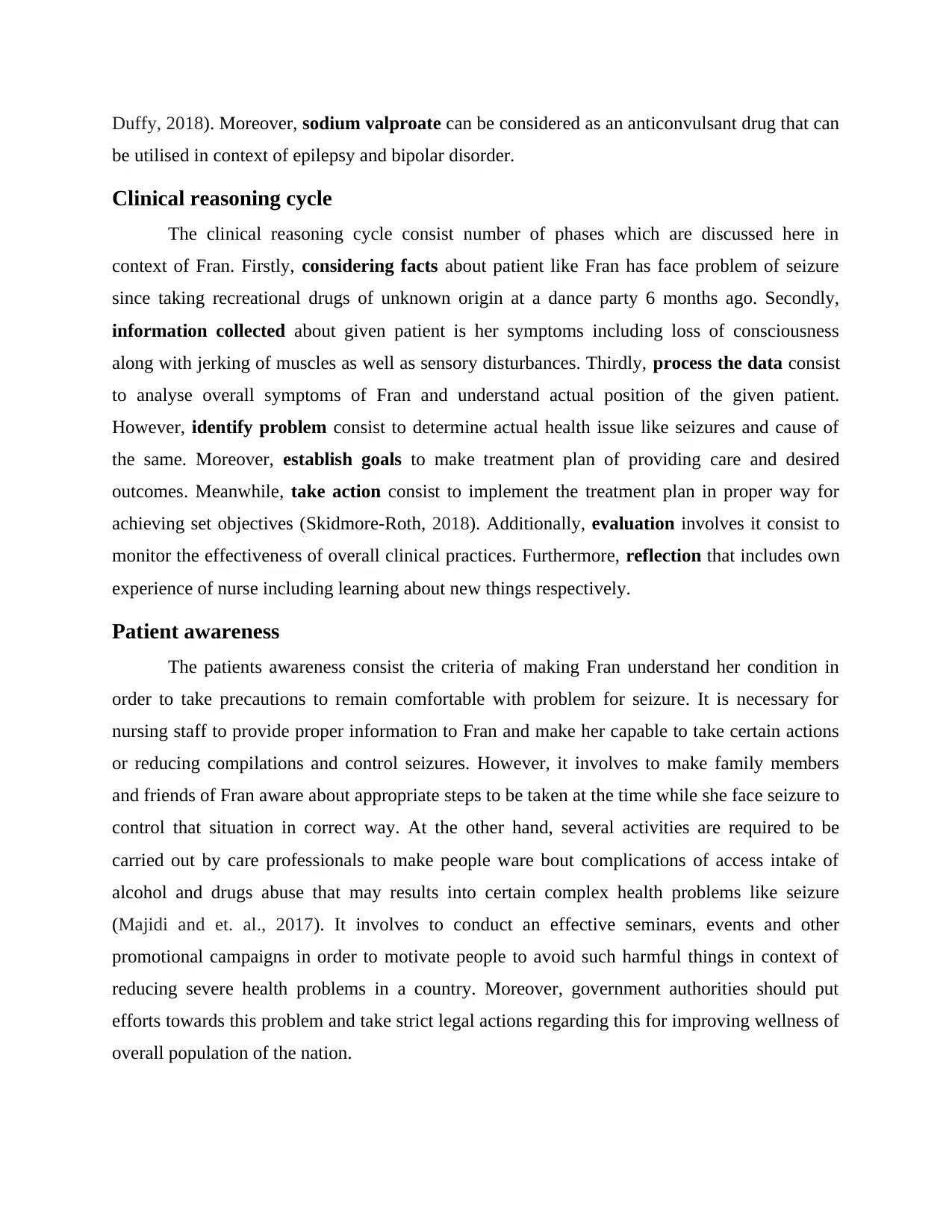
Duffy, 2018). Moreover, sodium valproate can be considered as an anticonvulsant drug that can
be utilised in context of epilepsy and bipolar disorder.
Clinical reasoning cycle
The clinical reasoning cycle consist number of phases which are discussed here in
context of Fran. Firstly, considering facts about patient like Fran has face problem of seizure
since taking recreational drugs of unknown origin at a dance party 6 months ago. Secondly,
information collected about given patient is her symptoms including loss of consciousness
along with jerking of muscles as well as sensory disturbances. Thirdly, process the data consist
to analyse overall symptoms of Fran and understand actual position of the given patient.
However, identify problem consist to determine actual health issue like seizures and cause of
the same. Moreover, establish goals to make treatment plan of providing care and desired
outcomes. Meanwhile, take action consist to implement the treatment plan in proper way for
achieving set objectives (Skidmore-Roth, 2018). Additionally, evaluation involves it consist to
monitor the effectiveness of overall clinical practices. Furthermore, reflection that includes own
experience of nurse including learning about new things respectively.
Patient awareness
The patients awareness consist the criteria of making Fran understand her condition in
order to take precautions to remain comfortable with problem for seizure. It is necessary for
nursing staff to provide proper information to Fran and make her capable to take certain actions
or reducing compilations and control seizures. However, it involves to make family members
and friends of Fran aware about appropriate steps to be taken at the time while she face seizure to
control that situation in correct way. At the other hand, several activities are required to be
carried out by care professionals to make people ware bout complications of access intake of
alcohol and drugs abuse that may results into certain complex health problems like seizure
(Majidi and et. al., 2017). It involves to conduct an effective seminars, events and other
promotional campaigns in order to motivate people to avoid such harmful things in context of
reducing severe health problems in a country. Moreover, government authorities should put
efforts towards this problem and take strict legal actions regarding this for improving wellness of
overall population of the nation.
be utilised in context of epilepsy and bipolar disorder.
Clinical reasoning cycle
The clinical reasoning cycle consist number of phases which are discussed here in
context of Fran. Firstly, considering facts about patient like Fran has face problem of seizure
since taking recreational drugs of unknown origin at a dance party 6 months ago. Secondly,
information collected about given patient is her symptoms including loss of consciousness
along with jerking of muscles as well as sensory disturbances. Thirdly, process the data consist
to analyse overall symptoms of Fran and understand actual position of the given patient.
However, identify problem consist to determine actual health issue like seizures and cause of
the same. Moreover, establish goals to make treatment plan of providing care and desired
outcomes. Meanwhile, take action consist to implement the treatment plan in proper way for
achieving set objectives (Skidmore-Roth, 2018). Additionally, evaluation involves it consist to
monitor the effectiveness of overall clinical practices. Furthermore, reflection that includes own
experience of nurse including learning about new things respectively.
Patient awareness
The patients awareness consist the criteria of making Fran understand her condition in
order to take precautions to remain comfortable with problem for seizure. It is necessary for
nursing staff to provide proper information to Fran and make her capable to take certain actions
or reducing compilations and control seizures. However, it involves to make family members
and friends of Fran aware about appropriate steps to be taken at the time while she face seizure to
control that situation in correct way. At the other hand, several activities are required to be
carried out by care professionals to make people ware bout complications of access intake of
alcohol and drugs abuse that may results into certain complex health problems like seizure
(Majidi and et. al., 2017). It involves to conduct an effective seminars, events and other
promotional campaigns in order to motivate people to avoid such harmful things in context of
reducing severe health problems in a country. Moreover, government authorities should put
efforts towards this problem and take strict legal actions regarding this for improving wellness of
overall population of the nation.
Paraphrase This Document
Need a fresh take? Get an instant paraphrase of this document with our AI Paraphraser
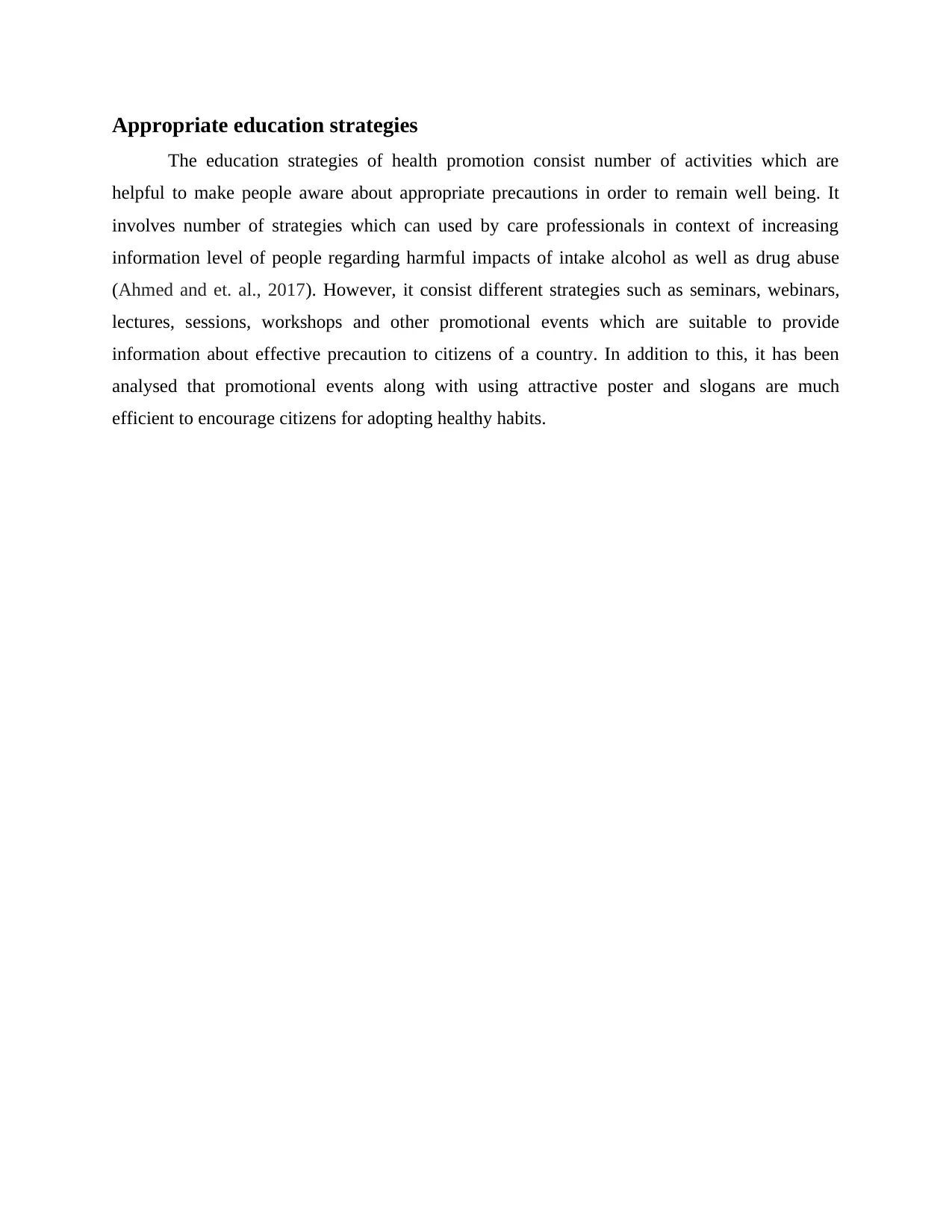
Appropriate education strategies
The education strategies of health promotion consist number of activities which are
helpful to make people aware about appropriate precautions in order to remain well being. It
involves number of strategies which can used by care professionals in context of increasing
information level of people regarding harmful impacts of intake alcohol as well as drug abuse
(Ahmed and et. al., 2017). However, it consist different strategies such as seminars, webinars,
lectures, sessions, workshops and other promotional events which are suitable to provide
information about effective precaution to citizens of a country. In addition to this, it has been
analysed that promotional events along with using attractive poster and slogans are much
efficient to encourage citizens for adopting healthy habits.
The education strategies of health promotion consist number of activities which are
helpful to make people aware about appropriate precautions in order to remain well being. It
involves number of strategies which can used by care professionals in context of increasing
information level of people regarding harmful impacts of intake alcohol as well as drug abuse
(Ahmed and et. al., 2017). However, it consist different strategies such as seminars, webinars,
lectures, sessions, workshops and other promotional events which are suitable to provide
information about effective precaution to citizens of a country. In addition to this, it has been
analysed that promotional events along with using attractive poster and slogans are much
efficient to encourage citizens for adopting healthy habits.
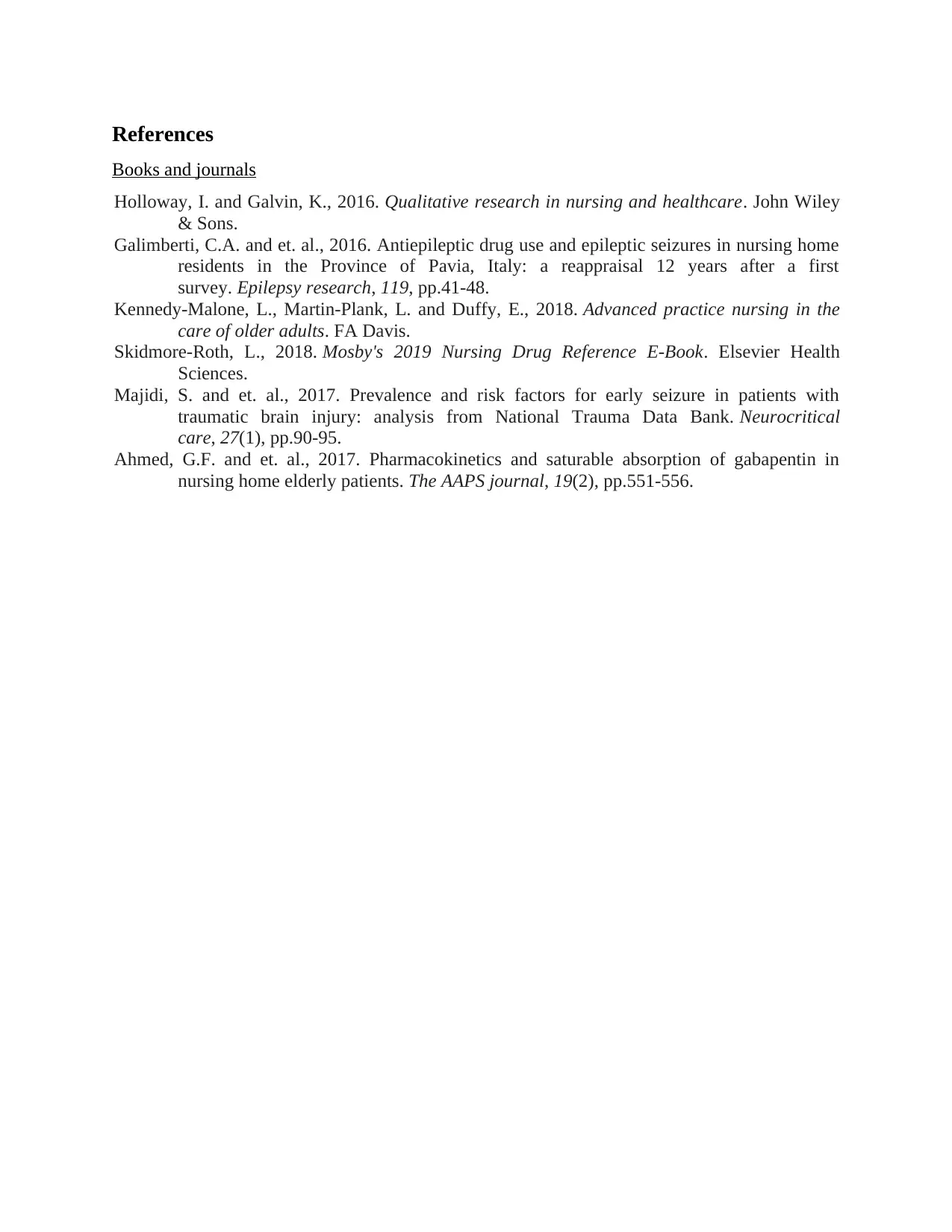
References
Books and journals
Holloway, I. and Galvin, K., 2016. Qualitative research in nursing and healthcare. John Wiley
& Sons.
Galimberti, C.A. and et. al., 2016. Antiepileptic drug use and epileptic seizures in nursing home
residents in the Province of Pavia, Italy: a reappraisal 12 years after a first
survey. Epilepsy research, 119, pp.41-48.
Kennedy-Malone, L., Martin-Plank, L. and Duffy, E., 2018. Advanced practice nursing in the
care of older adults. FA Davis.
Skidmore-Roth, L., 2018. Mosby's 2019 Nursing Drug Reference E-Book. Elsevier Health
Sciences.
Majidi, S. and et. al., 2017. Prevalence and risk factors for early seizure in patients with
traumatic brain injury: analysis from National Trauma Data Bank. Neurocritical
care, 27(1), pp.90-95.
Ahmed, G.F. and et. al., 2017. Pharmacokinetics and saturable absorption of gabapentin in
nursing home elderly patients. The AAPS journal, 19(2), pp.551-556.
Books and journals
Holloway, I. and Galvin, K., 2016. Qualitative research in nursing and healthcare. John Wiley
& Sons.
Galimberti, C.A. and et. al., 2016. Antiepileptic drug use and epileptic seizures in nursing home
residents in the Province of Pavia, Italy: a reappraisal 12 years after a first
survey. Epilepsy research, 119, pp.41-48.
Kennedy-Malone, L., Martin-Plank, L. and Duffy, E., 2018. Advanced practice nursing in the
care of older adults. FA Davis.
Skidmore-Roth, L., 2018. Mosby's 2019 Nursing Drug Reference E-Book. Elsevier Health
Sciences.
Majidi, S. and et. al., 2017. Prevalence and risk factors for early seizure in patients with
traumatic brain injury: analysis from National Trauma Data Bank. Neurocritical
care, 27(1), pp.90-95.
Ahmed, G.F. and et. al., 2017. Pharmacokinetics and saturable absorption of gabapentin in
nursing home elderly patients. The AAPS journal, 19(2), pp.551-556.
⊘ This is a preview!⊘
Do you want full access?
Subscribe today to unlock all pages.

Trusted by 1+ million students worldwide
1 out of 6
Your All-in-One AI-Powered Toolkit for Academic Success.
+13062052269
info@desklib.com
Available 24*7 on WhatsApp / Email
![[object Object]](/_next/static/media/star-bottom.7253800d.svg)
Unlock your academic potential
Copyright © 2020–2025 A2Z Services. All Rights Reserved. Developed and managed by ZUCOL.


